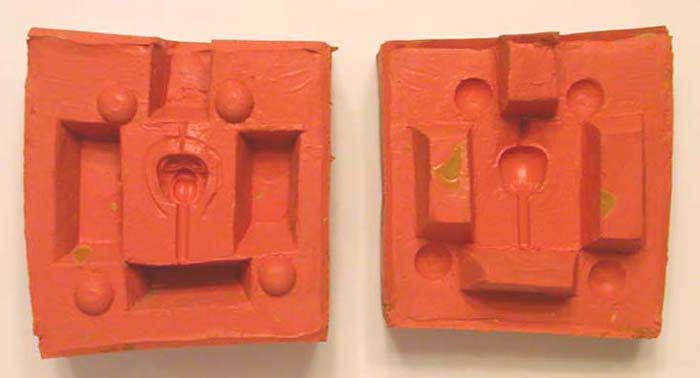


| Walrusman Head Silicone Mold | |
| Many different stages of prototypes exist offering various
glimpses into the production process. Among the various stages exist prototypes which put a smile on one's
face while viewing and others that induce head-spinning awe. The Walrusman head
silicone mold found here
certainly falls into the uber exciting category for many prototype collectors including myself. Taking into account the miniscule amount of
available prototypes for A New Hope 3 3/4" characters and considering the paltry amount of figural silicone molds known
to exist makes this mold a very significant find. The term "rare" is immensely applicable in this instance
as silicone molds are know to exist for portions of fewer than ten 3 3/4" characters. A
Rancor Keeper torso,
alternate Han Carbonite block, produced version Han Carbonite block, and unproduced 2nd series Ewoks Chief Chirpa
represent the other 3 3/4" figure silicone molds available for viewing on the Archive. Silicone molds for Micro Collection 4-ups exist in larger
quantities, however even micro molds are difficult to pry from collections in which they reside.
This silicone mold was created by using the original wax sculpting of the Walrusman figure's head. A silicone mold is crafted for each piece of the figure. In other words a "complete" mold series is comprised of individual molds for the head, arms, legs, and torso. Each mold is utilized to yield urethane hardcopy parts. The pliable nature of a silicone mold allows for removal of the hardcopy part once the liquid urethane has solidified. Later the hardcopy parts are pinned together using dowels, usually metal dowels, to form an entire figure which ultimately serves as a tooling master, paint master, or photography/industry show sample.
The reddish colored silicone material of this mold appears prevalent on earlier pre-ROTJ molds. ROTJ and beyond 3 3/4" figure silicone molds known to exist are white in coloration. It's difficult to make a definitive statement on this issue, but this color-time correlation is certainly an emerging trend at this point. Notice the presence of negative rectangular areas and positive circular areas found on the front mold half above. These features are referred to as "keys" and enable the two mold halves to line up correctly when joined together to cast a hardcopy. The keys on the companion rear mold half are opposite of what is seen on the front. In other words, the rectangular keys are positive while the circular keys are negative. The small channel surrounding the head allows trapped air and excess resin to move from the head cavity thus assisting in the prevention of air pocket formation.
Above, we see a nice close-up view of each mold half. Keep in mind the head cavity is a negative impression of the Walrusman head having been created from the positive wax sculpting. The facial detail present in the mold shows through very nicely. You'll notice a small triagular channel extending up from the head cavity. It appears this triangular represents the area, referred to as a "gate", where liquid urethane entered into the head cavity. It isn't apprent from the picture, but Bill astutely noticed the positive key above this gate appears to have been removable at one point. The removal of this key would allow access for the entrance of liquid urethane from the outside of the mold while the two halves were joined. Silicone molds require an external access point to make them functional.
The photographs above offer two views different views of the joined mold halves. The left picture shows the mold halves oriented like a sandwich resting on a plate. The right picture portrays the bottom view of the combined mold halves.
We finish with a closer picture of the joined mold bottoms. Take note of what appears to be the presence residual urethane. The brownish material appears to be carbalon while the green material appears to be dynacast. Astute viewers will notice further evidence of residual carbalon present in some of the other pictures as well. I cannot thank Bill enough for graciously submitting photographs of this incredibly significant prototype from his collection. The generous nature of Bill and other collectors make it possible for the Archive to continue offering detailed glimpses into the production process associated with our favorite Kenner toy line. |
| Description by: | Michael G. Mensinger |
| Photo: | Bill Wills |
| From the collection of: | Bill Wills |
| Country: | United States |
| Film: | A New Hope |
| Licensee: | Kenner |
| Year: | 1977 |
| Category: | Prototypes / Action Figure Related |